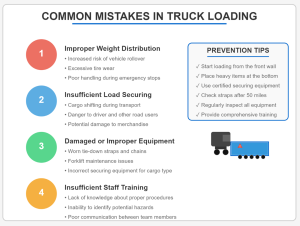Even a single violation of truck loading safety rules and guidelines can pose a serious risk to the driver and other road users. Not to mention the financial losses and potential legal consequences. Get familiar with the most common mistakes that can jeopardize the entire logistics chain—and more importantly, with effective practices to prevent them.
In the world of logistics, a chain is only as strong as its weakest link. So let’s take a closer look at the most high-risk moments during loading and find out how to avoid situations where a seemingly routine task turns into a nightmare.
Improper Weight Distribution—The Silent Enemy of Stability
Unevenly distributed cargo isn’t just a theoretical issue—vehicles with unbalanced loads show significantly reduced driving performance, especially during emergency braking or evasive maneuvers. Tires on the overloaded side also suffer from excessive wear, further reducing the safety margin.
Experts in truck loading safety consistently apply a simple yet effective rule: always start loading from the front wall of the trailer and work evenly toward the rear. Heavier items are placed at the bottom and as close as possible to the vehicle’s longitudinal centerline. Throughout the entire process, weight distribution is checked regularly, and item positions are adjusted as needed.
To determine axle loads accurately, specialized software tools are available. These simulate various loading scenarios and instantly show how a specific cargo arrangement will affect each axle.
Insufficient Load Securing—When a Ton of Steel Starts to Move
Even perfectly distributed cargo becomes deadly if it’s not properly secured. During transport, significant forces act on the load—under hard braking, these forces can reach up to 80% of the cargo’s weight in the forward direction. So if you’re hauling ten tons, you need to account for up to eight tons of forward force. No driver can stop cargo that starts moving with full inertia during a collision.
Loading dock safety serves as the first line of defense—it provides a stable environment for properly securing cargo before the journey begins. During the securing process, it’s essential to use certified tie-down equipment suitable for the weight and nature of the transported goods. Anti-slip mats and edge protectors are also recommended to evenly distribute pressure and prevent shifting.
Experienced drivers also follow the “first 50 miles rule”—after driving this initial distance, they advise stopping to check the cargo and retighten the straps if necessary. As cargo tends to settle during transport, previously tight straps may loosen.
Tip: Learn more about proper cargo distribution here.

Damaged or Inappropriate Equipment—When Technology Fails
Ensuring a high level of truck loading safety requires not only proper procedures but also reliable equipment. Regular inspection of securing tools is an investment that pays off many times over. Worn-out straps, rusty chains, or damaged locking devices have significantly reduced strength—and under heavy load, they can fail without warning.
Logistics companies, therefore, implement systematic inspections of all equipment before every loading operation. Any damaged component is immediately taken out of service, significantly increasing truck loading safety. The same principle applies to handling equipment such as forklifts and pallet jacks, whose failure during loading or unloading often leads to serious accidents.
Loading and unloading safety also depends on strict adherence to the load capacity of each piece of equipment—exceeding these limits dramatically increases the risk of failure. Experienced managers ensure regular preventive inspections and timely replacement of worn-out parts.
Insufficient Staff Training—The Human Factor Makes the Difference
Even the most advanced truck loading safety systems cannot replace qualified and well-trained personnel. Inadequately trained workers pose a critical risk—despite their enthusiasm or best intentions, they often lack the knowledge required to identify potential hazards.
Effective truck loading safety practices, therefore, include regular training sessions. These go beyond theoretical knowledge and involve hands-on exercises covering proper loading techniques, securing various types of cargo, and handling emergency situations.
Modern logistics companies also develop standardized operating procedures (SOPs) that clearly define every step of the loading process. These procedures include checklists to help even less experienced workers identify potential risks. Systematically building a culture of safety not only reduces the number of accidents but also improves the overall efficiency of the process.